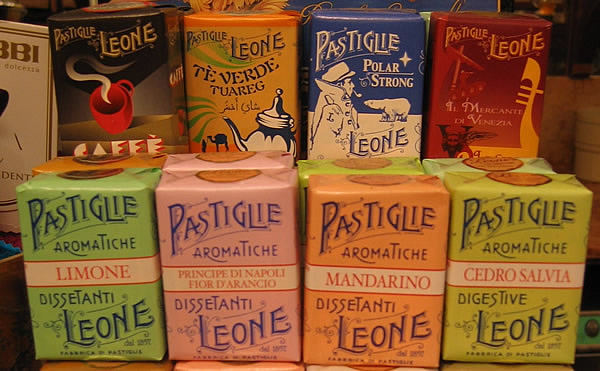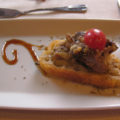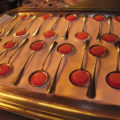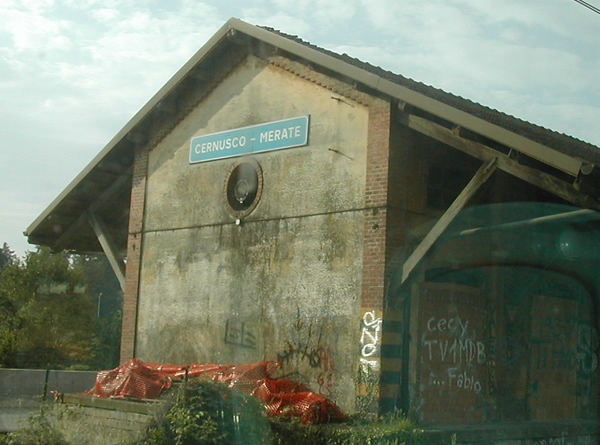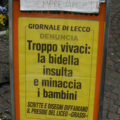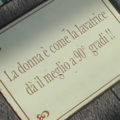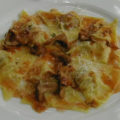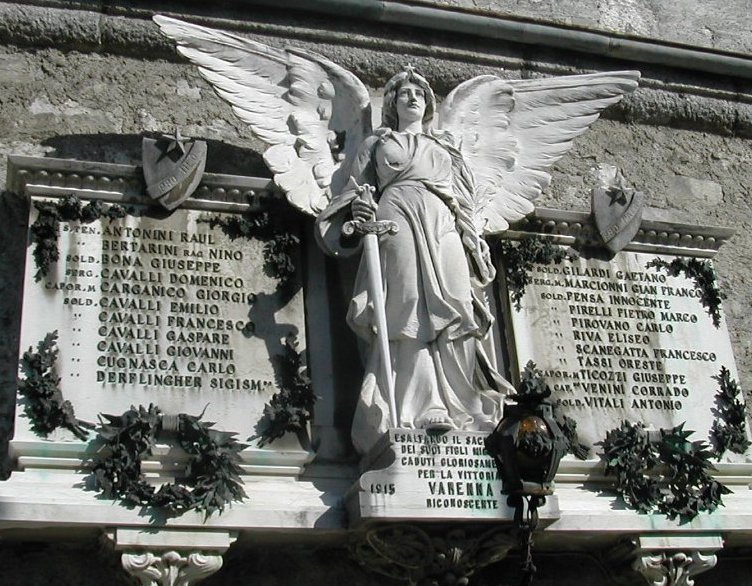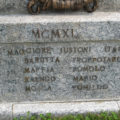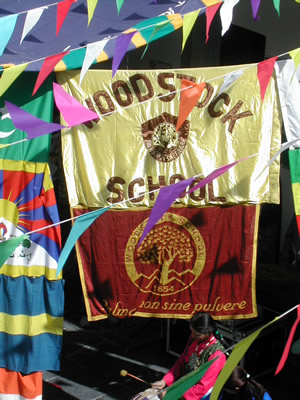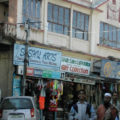Leone brand candies have been around for a long time in Italy. I love the Art Deco and Art Nouveau package designs. The flavors are interesting, in concept, at least: coffee (I want a poster of this box!), Tuareg green tea, Polar strong, the Merchant of Venice (spices, I’m guessing), Lemon, Prince of Naples Orange Flowers, Mandarin (these three are “thirst-quenching”), and Lime Sage (“digestive”). And this was only half the packages on display. Photo taken at Bar Santa Marta, via Mascari, Lecco (which also features the best breakfast pastry in town).
Italian SMS-Speak
“Texting” – sending text messages via cellphone – has been popular in Italy far longer than in the US, in part because it’s cheaper than calling. When I can’t reach someone by email, I use SMS for non-urgent communications – it’s less intrusive than a call, and I have a phobia of disturbing people.
Italian kids in particular text a lot, though many have now moved on to instant messaging on their computers. They’ve developed a shorthand which is useful for both; I give some examples here (and will expand on them as I run into new ones, particularly with illustrations).
The graffito on the side of the building pictured above reads: Cecy TV1MDB… Fabio.
TVB – ti voglio bene – “I love you” – predates cellphones; I remember my daughter and her middle school friends scribbling it on each others’ school diaries and backpacks. (The advertising applications for TVBLOB are instantly apparent.)
The graffito above is another variant: 1 is (obviously) uno, the number one, but it’s also the article “a” or “an”. So this reads: Ti voglio un mondo di bene – “I desire for you a world of good,” or “I love you a lot.”
Cecy, BTW, pronounced CHAY-chee, is a nickname for Cecilia [cheh-CHEE-lee-ah].
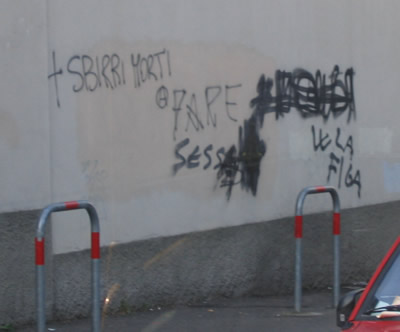
+ is of course the mathematical plus sign, pronounced piu’ [PYOO]. But piu’ also means “more”. So the ugly sentiment expressed above is “more cops dead.”
At the bottom right is the VV symbol meaning “hurray for!” – figa (cunt). (A rather pleasanter sentiment.)
Other Abbreviations
(For which I don’t yet have photos.)
6 – sei means “six” or “you are”.
cmq – comunque – anyway
k – The letter k is pronounced kappa in Italian (the name is Greek because k is not actually part of the Italian alphabet). But Italian kids, knowing that in English it’s pronounced [kay], use it as shorthand for -che, a common Italian syllable.
x – This is not the letter x, but the multiplication symbol, called per in Italian. The word per is also a preposition meaning “for”, and, again, a frequently-used syllable in Italian.
So: xk = perché – “why?” – a savings of four letters when entering text!
what are some more Italian SMS abbreviations I’m missing?
Italian Milk
It’s the Little Things That Surprise You
When you move to a foreign country, you expect (if you are wise) that the food will be different from what you’re used to. For the adventurous this is a welcome change, a chance to explore new flavors and habits (though sometimes you also crave the taste of home, wherever that is for you).
It takes you by surprise, though, when even the basics are different.
When I was a kid, milk was simple. In Bangkok, the Foremost milk truck came to our house once a week. It was a huge refrigerated vehicle with thick little doors on the sides that opened to disgorge wonderful things: milk in orange and white cartons, ice cream, and fudgesicles. I don’t know if Foremost even had a skimmed milk option in those days; I don’t remember ever seeing it.
In the US, milk came in the same paper cartons and in big white plastic gallon jugs. We always bought gallons, and the jug was always finished before the milk went bad, in part because I drank it so fast. But even as I got older and drank less milk (when I returned to the US for college), I still bought gallons, and it never went bad.
One of the first things that surprised me in Italian food shops was the size of the milk: it came in half-liter or liter Tetra pak bricks, nothing larger. A family of three or four, especially with small kids, would easily go through one or more liters a day, and one of the cliches of Italian family life is someone having to run out to a neighborhood shop early in the morning to get milk for the family breakfast (tall, steaming mugs of hot milk, with the kids having a drop of coffee in it Рcaff̩ latte Рeven from very young ages).
So why wasn’t milk available in larger packages? I soon found out: it goes bad incredibly quickly. Once opened, a carton has to be finished in a day or two, three if you really push it. I initially blamed this on the packaging: the only way to open a Tetra pak brick is to cut or rip a corner off it. This can make for messy pouring (depending on the cut you make and whether you are able to hold the full brick without squeezing), and then the carton can’t be closed again in any meaningful way. At least American-style half-gallon milk cartons fold in on themselves to protect their contents.
A few years after we moved to Milan, innovations in milk packaging began to appear on supermarket shelves: round Tetra pak cartons with screw-on lids, American-style fold-in cartons (though only in a half- or one-liter size, the latter very similar to an American quart carton), and plastic bottles. At least one ecologically-minded company offered returnable glass bottles, but that didn’t last long.
However, even in resealable packaging, the milk still went bad quickly. I guess we drink less than the average Italian family. It tasted different, too. Better, worse, I don’t know – it wasn’t like the American milk I was used to, but it was certainly drinkable, and anyway I was drinking far less than I had in childhood.
But I do like milk in my coffee, and with the cereal I sometimes eat (Ross practically lives on Special K, which tastes far better in Italy than in its native land, interestingly). I’m a disorganized shopper at best, and, especially where we live now, running out in the morning to grab some milk is not an option. So trying to keep fresh milk in the house is a constant irritant.
An alternative you have probably thought of, if you’ve lived anywhere outside the US in your lifetime, is UHT milk: the ultra-high temperature process it’s subjected to gives it a shelf life of months. But it tastes horrid, and some brands worse than others. I know people who drink it all the time and are happy. I could never get used to it.
Lately there’s a new kid on the block, micro-filtered milk. I don’t know what exactly micro-filtering consists in, but the flavor is excellent and it keeps for weeks. (Maybe this is the process they’ve been using in the US all along?) This is now my milk of choice, when I can find it. Stores aren’t stocking it much yet, perhaps because the public is suspicious. Our friend Michele, who used to own a bakery (and bakeries always sell milk for those early morning breakfast emergencies), said his customers wouldn’t buy it.
I do, whenever I can. It’s so nice to be able to stock up and know that I don’t have to think about buying milk for a while!
May 10 – One of the commenters on this article wondered why you can’t buy milk in Italy in a reseable one-gallon plastic jug. Aside from the aforementioned spoilage problem, there’s also a problem of space: Italian refrigerators are much smaller than American ones, reflecting the fact that Italians shop more often, and their homes are smaller. Even in our big new house, the “big” new refrigerator we bought is only 60 cm wide.
Many American fridges these days are built with very deep doors where big beverage bottles and jugs can be stored for easy access. In Italy, it can be difficult to fit a two-liter bottle anywhere at all.
What food surprises have you encountered in a new country?
Old-Fashioned Italian Baby Names
Above: a monument to Varenna’s WWI dead. If your last name was Pensa (“think”), why would you name your child Innocente? Monuments like this also give clues to names which were once common but have now fallen out of popularity: Gaspare [GAHS-pah-ray], Eliseo [ell-lee-ZAY-oh], Oreste [oh-RES-tay], Sigismundo [sih-jiss-MOON-doh] and Corrado [cor-RAH-doh] are very rare today.
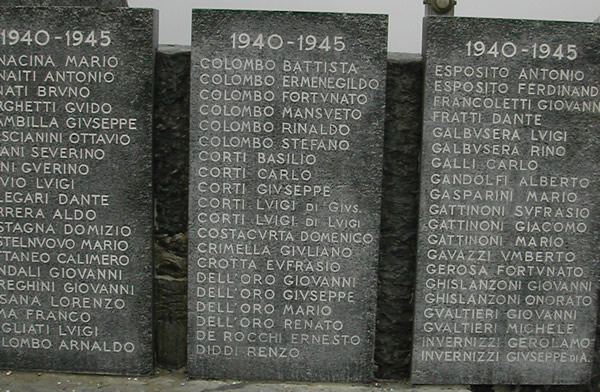
War memorial in Lecco: more names which are now rare (and might be considered funny):
- Ermenegildo [air-may-nay-JEEL-doh]
- Eufrasio [ey-you-FRAZ-ee-oh]
- Mansueto [mahn-SWAY-toh] (“gentle”)
- Fortunato [for-too-NAH-toh] (“lucky,” but this may also be the name of a saint)
- Onorato [on-oh-RAH-toh] (“honored”)
- Severino [seh-veh-REEN-oh] (a saint)
- Domizio [doh-MEET-zee-oh] (Roman name)
- Calimero [cah-lee-MARE-oh]
- Arnaldo [are-NAHL-doh]
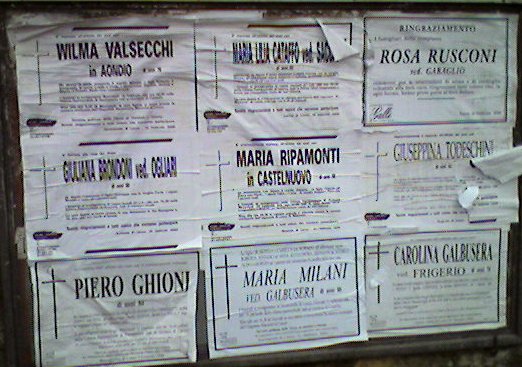
Wilma [VILL-mah] and Giuseppina [jews-ep-PEEN-ah] would be considered old-fashioned. Carolina [car-oh-LEAN-ah] is still current (my daughter has been at school with at least one Carolina).
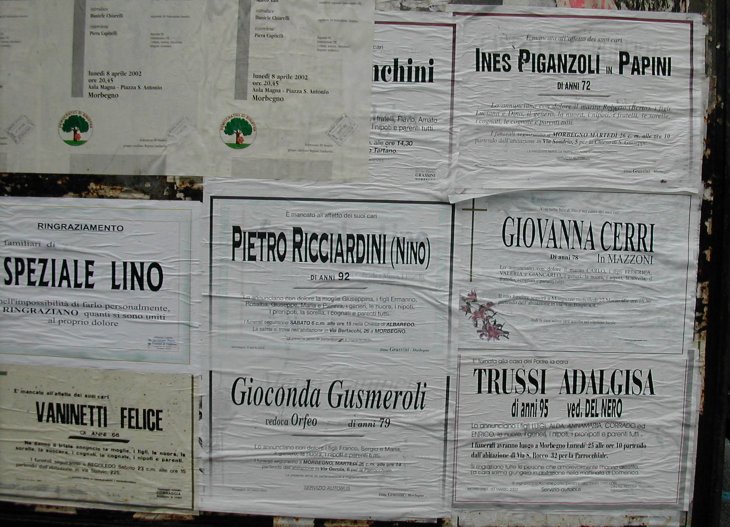
- Ines [ee-NESS]
- Gioconda [joe-COND-ah] – In Italy, an alternate name for the Mona Lisa is La Gioconda. Note that this one was the widow of a Mr. Orfeo [or-FAY-oh] (Orpheus).
- Adalgisa [ah-DAHL-jizz-ah] – Very old-fashioned.
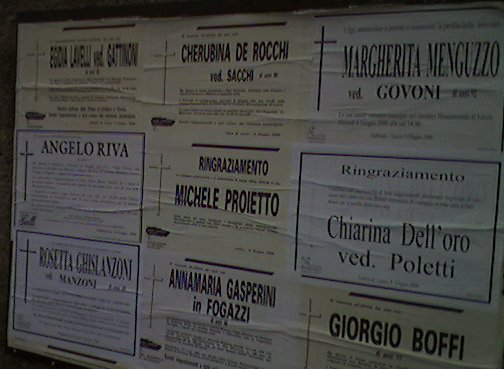
- Egidia [eh-GEE-dee-uh]
- Rosetta [Rose-ETT-uh]
- Cherubina [care-oo-BEAN-uh] – “Little Cherub” – Huh?!?
- Chiarina [kya-REE-nah] – unusual, but cute. A diminutive of Chiara [KYA-rah], meaning clear, transparent, or light.
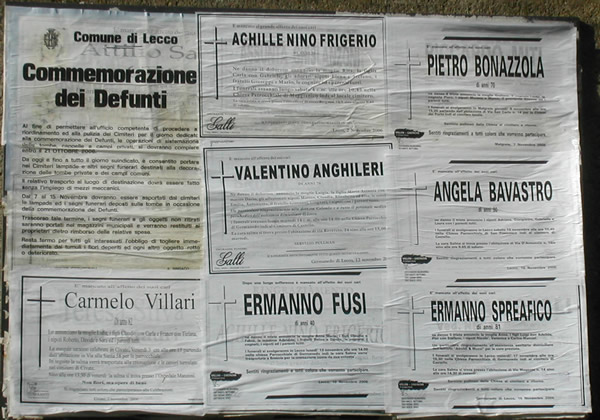
- Achille = Achilles
- Valentino – well, you all know that one
- Ermanno – no less than two of them! = Herman
- Carmelo – very current in southern Italy
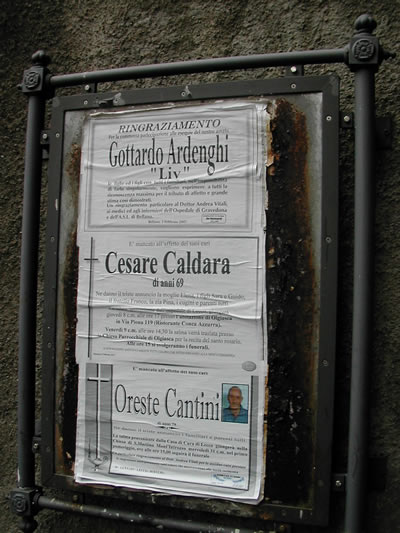
- Gottardo [go-TAR-doh] – a saint with an important Alpine mountain pass and two major highway tunnels named after him.
- Cesare [CHAY-za-ray] – Caesar. You knew that, right?
- Oreste [o-RESS-tay] – the Greek Orestes
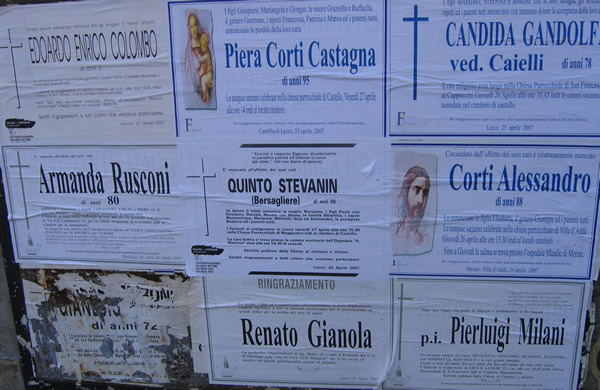
- Edoardo Enrico – It’s unusual for an Italian to use a middle name in any context. My husband, for example, has several which may be on his baptismal certificate, but do not exist on his birth certificate or any other legal document, and which are never used. Beyond that, Edoardo [eh-doh-AR-do] and Enrico are both names that are not unusual, but not overly common, either.
- Piera – [pee-AIR-a or PYAIR-ah] Female version of Piero, of course.
- Candida [CAHN-did-ah] – Carries the connotation “white” or “pure.”
- Armanda [ar-MAHN-dah]
- Quinto [KWEEN-toh] – “Fifth”.
In some families it seems to have been the practice, dating back to Classical Rome, to give your children numbers rather than names: Primo, Secundo, etc. Or, having grown tired of trying to find names after the first few, the parents seem to take this easy way out. - Pierluigi – Pier is often used as a sort of adjunct to other (male) names: Piergiorgio, Pierluigi, even Piermaria (still a male name by virtue of the Pier on the front).
Anything you can add on the lore and history of old-fashioned Italian names will be welcome!
Related: Italian Baby Names I Happen to Like
Getting Ready for Woodstock School – Some Practicalities
So my daughter will be going to Woodstock School. Given my obvious enthusiasm for the place, you may assume that I’m ecstatically happy about this – and I am. But there is also plenty of room for doubts and worries and sorrow. What do I do with feelings like these? What I always do: write about it! <wry grin>
First, there’s the practical side: we have a lot to do to get ready. So, for the benefit of other current and future Woodstock parents, I figured I might as well write about that.
Health
Every seasoned traveller knows that before travelling to (what used to be called) third-world countries, you need to get shots. Ross and I went through this two years ago in preparation for our trip to India in the summer of 2005. The travellers’ health clinic of our local health agency in Lecco was able to advise on and administer everything we needed. Ross made an appointment to check what was needed this time around. Since she’s still a minor, I had to go with her.
Turns out we had forgotten to get her Hepatitis A booster that was due 6-12 months after the first one – the nurse scolded us, but didn’t seem to think it was really a big deal. She gave us a lecture (again) on when Ross should take malaria prophylaxis, and that was that – at a cost of 45 euros.
Enrico is concerned about health care for Ross at Woodstock – not that she has any special needs, he’s just worried about health in India in general (although, during our trip in 2005, it was me who got sick, not Ross).
There wasn’t much information on the school or SAGE website about this (an oversight now being remedied), but I know that the school has its own health center with nurses and a doctor, and that Landour Community Hospital (LCH), where many Woodstockers were and still are born, is just outside the school gates. I also know that India can boast world-class healthcare these days, at least in the big cities – indeed, “health tourism” is becoming a booming business.
As it turns out, LCH is getting a facelift (maybe much more – I don’t have details yet), thanks to my classmate Sanjay (who has also revamped the school’s kitchens – an area of natural interest for him as he’s in the restaurant business). So the quality of care available right on Woodstock’s doorstep is improving.
There is also some sort of catastrophic health insurance available through SAGE I think, we’re waiting to hear about that from them. I’m not sure it provides for a medical evacuation to the home country, but someone mentioned that it would pay a ticket for a parent to come in case of serious hospitalization. I’ll report the details when I have them.
The SAGE package we received recently includes a medical history and a form to be filled out by our family doctor with data from a physical exam, plus Ross will have to get blood, urine, and stool tests. This all makes sense – the school needs to know up front that these kids don’t have health problems when they arrive. But it’s going to be a mad scramble to get it all quickly – SAGE wants these forms back by June 1st.
Normally such tests might be free or subsidized in the Italian health care system, but waiting times can be so long for non-emergency testing that I’ll probably have to pay to have the lab work done privately. At least the exam by the family doctor shouldn’t cost.
What to Bring?
It may seem ironic for a school in India, but my greatest concern in this category is warm clothing. Woodstock is 7000 feet up in the “foothills” of the Himalayas, where it’s plenty cold and snowy in winter, and most of the buildings are far too old to have anything like central heating.
For this reason, the school year traditionally ran from late July to late June, with the long vacation from early December to mid February. It could still be bitterly cold even in late February – I remember one year when music practices were suspended because our fingers were too stiff to play.
Lucky Ross: the school calendar is changing this year, with classes starting August 8th, vacation December 14-Jan 22, and graduation May 30th. The idea is to align Woodstock with US schools and colleges, in part to have more time to prepare for AP exams in the spring. So the students will be in Mussoorie for much of the winter – brr!
Ross initially pooh-poohed my suggestion of long underwear (SO unfashionable). I have tried to explain to her that you’ve never known real cold until you’ve had chilblains. I’m buying her the long underwear anyway – and she’s more convinced now that she’s seen it on the packing list we just received from SAGE. At least she recognizes the depth of motherly love demonstrated by my offer to give her my very warmest ski socks (I have a fetish for socks, and my feet are always cold).
Ross has also been put in touch with a current SAGE student whose advice she can ask on what else is and isn’t needed.
One major purchase will be a laptop; though the school has computers for student use, Ross is accustomed to having her own: at home she uses my “old” desktop, and she can’t imagine life without it close at hand to organize and PhotoShop her photos.
Student Visa
I dread facing the Indian consulate in Milan again, it’s always chaos. We will have to go there to get Ross a student visa for India, but we can’t do it until after June 1st (at the earliest), because the visa is good for exactly one year. Getting the visa should be straightforward – the school is sending a “bona fide student” letter vouching for her status. But I’m always afraid that something will go wrong with this, so I won’t really rest easy until she’s got that damned visa in her passport.
It’s amusing to compare and contrast all this with my own thirty-year-old memories of preparing for Woodstock.
Your thoughts?

